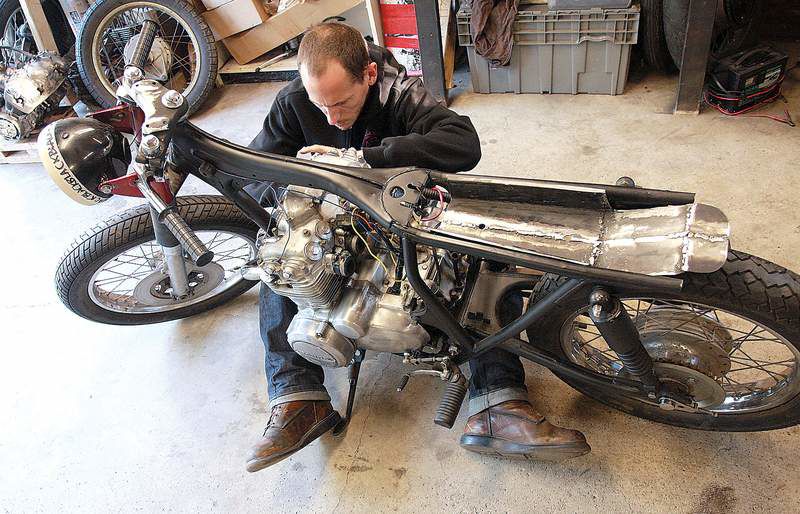Motorcycles stripped down to suit a skateboard aesthetic
Published 5:00 am Friday, July 23, 2010

- Lee Bender works on one of his modified Honda motorcycles in his garage in Indianapolis in April. After nearly 20 years of skateboarding, Bender, who learned he had multiple sclerosis in 2007, went from riding skateboards to riding motorcycles as a way to find new expressions of freedom and preserve his independence.
INDIANAPOLIS — When Lee Bender learned in 2007 that he had multiple sclerosis, he knew right away that his all-consuming passion of nearly 20 years, skateboarding, would no longer be possible.
“I was sponsored, skating quite a bit, traveling quite a bit, but that all came to an end,” he said, referring to his time on tour representing skate gear makers. “My balance is off, so anything that rolls underneath my feet is completely foreign feeling.”
What rolls underneath his seat is a different story.
Though his own transition from four wheels to two was compelled somewhat by circumstance, Ben-der, a wiry, tattooed, 31-year-old from northeast Indiana, was not alone among skateboarders who have found new expressions of freedom in motorcycles.
“On a baseball team, you’ve got a coach yelling at you, ‘Go faster, do this, do that,’” he said. “With skateboarding, I could do whatever I wanted.”
Motorcycles preserved his independence, Bender said. “I’m in control of the bike. I do what I want with it.”
And at least one motorcycle maker has noted the similar mind-sets of skaters and riders. Harley-Davidson is using star skateboarders to promote a new variation of its Sportster model.
“We definitely looked at what these guys were doing and what other guys were doing, and what we saw was this trend toward raw and stripped down,” said Paul James, director of product communications at Harley-Davidson.
Bare-bones
For skateboarders who grew up dodging cars — and often, the security guards who looked after their impromptu practice spots — the requirements of a good bike can be reasonably straightforward: a durable machine that makes the trip to and from the skatepark but doesn’t draw too much attention, the deafening blast of its modified exhaust pipes notwithstanding.
Then there are the skateboarders whose urge to build something more personalized extends to motorcycles. The bikes are customized, but rarely are they chrome cruisers with stretched out front ends and the high-rise handlebars known as ape-hangers. These are sleek stripped-down machines, recalling a style, popular after World War II, in which owners chopped away excess to make their bikes leaner and faster.
Whether it’s a Honda CB350 whittled to the frame in the style of a cafe racer or a 1960s Harley, stripped of its fenders and fitted with a “panhead” engine, there is a bare-bones aesthetic to many of the machines. Typical design features of the genre include custom handlebars, fenderless front wheels, suspensions shorn of all extraneous brackets and no-frills seating for just one person.
Bender’s bike started as a 1996 Harley-Davidson Sportster; chrome plating had been lavished on its engine. Today, the engine is just about the only part original to the bike, and most of its chrome has been stripped off.
His modifications include a new low-slung frame, a vestigial wind deflector fashioned from a section of rear fender and handlebars that are startlingly narrow — just 16 1/2 inches wide.
A natural convergence
In some ways, an overlap of the skater and biker subcultures seems almost inevitable. Long gone are the days when skateboarders all resembled landlocked surfers, with fluorescent knee pads and long, baggy “board shorts.” Today’s skaters are just as likely to be bearded and dressed entirely in black, tattooed to the knuckles of fingers festooned with skull rings.
More important, there’s the philosophical alignment: a shared attitude that prizes freedom and scoffs at rules, for which the road-worn renegade provides the ultimate symbol.
“Skateboarding and motorcycling kind of have the same energy to them, where, if I want to go out and ride, I go out and ride, either on a skateboard or a motorcycle,” said Rick Eusey, a wild-haired 27-year-old, tattooed from knuckles to throat, who is a longtime friend of Bender’s. “I end up just doing my thing. I don’t need anybody else around.”
Eusey started skating at a young age, and eventually earned sponsorships and took part in professional skate tours. He shared a house here with Bender until last month, when they rode their motorcycles to San Francisco, where Bender works at an auto glass shop and Eusey works the door at a bar.
The previous owner of Eusey’s 1999 Sportster 1200 had added lots of chrome parts, big accessory lights and a large gas tank.
“Basically, I went through, stripped off everything that I could,” he said. “What I’ve tried to do is make it as bare-bones as possible.”
There is a “Road Warrior” quality to many skaters’ bikes. Eusey’s Harley, for example, has a hatchet bolted to the frame (handy when camping out) and foot pegs made from railroad spikes. But elegant flourishes often emerge: He recently repainted his gas tank in a psychedelic wild cherry sparkle finish accented by tiny flakes of silver and stripes of gold.
The crossover of skateboarding’s design culture to motorcycles has been embraced by Harley-Davidson. A promotional video for a new model in the Sportster line, the Forty-Eight, features skateboard heroes like Leo Romero, Heath Kirchart, Brian Hansen and Matt Ball. And the Forty-Eight comes tailored with some of the styling elements favored by skaters, including a solo seat, forward-mounted controls and a 2.1-gallon peanut tank.
“The trend is certainly broader than skateboarding, but I feel like it started there — maybe it’s purest there,” James said, noting that the enthusiasm seems to have spread to groups like snowboarders as well. “Skateboarding could very well be the epicenter. There’s no question that there are huge parallels there between bikers and skateboarders.”






